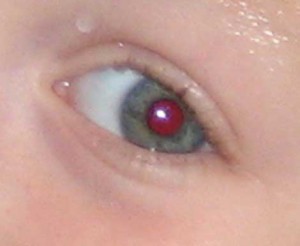Why Do Eyes Look Red in Photos?
The appearance of red eyes in pictures, known as the “red-eye effect,” occurs when a camera captures light reflecting from the retina at the back of your subject’s eye when a flash is used at night and in dim lighting. Eyes look red in photos due to the rich blood supply of the choroid, a layer of connective tissue at the back of the eye that nourishes the retina and gives it its  normal red color. When a camera flash goes off, the pupils of your subject’s eyes don’t have time to constrict to reduce the amount of light entering their eyes. Therefore, a large burst of light reaches their retinas, reflects back, and is captured on film.
normal red color. When a camera flash goes off, the pupils of your subject’s eyes don’t have time to constrict to reduce the amount of light entering their eyes. Therefore, a large burst of light reaches their retinas, reflects back, and is captured on film.
How Can You Prevent Red Eyes in Photos?
1. Don’t look directly at the camera. Tell your subjects to look slightly away from the lens, so their eyes won’t catch the flash at a direct angle. This will reduce the likelihood of red eyes in pictures.
2. Make the room brighter. The darker the environment, the more dilated the subject’s pupils become, which increases the likelihood of red-eye effects in photos. Making the room less dim by turning on more lights can help eliminate red eyes.
3. Turn on the anti-red-eye function. Most modern cameras have this feature. Red-eye reduction functions emit short flashes of light in quick succession before the camera actually takes the picture.
The burst of light beforehand makes the subject’s pupils constrict, and there’s not enough time between flashes for them to re-dilate, thereby reducing the red-eye effect in photos.
The more distance between the lens and the flash, the less likely you will have red eyes in pictures.
4. Move the flash and the lens further apart. This method doesn’t work for internal-flash cameras, but if you have an SLR (single lens reflex) camera, use an external flash that connects to your camera. Moving the flash further away from the camera body will prevent light reflecting from your subject’s pupils from entering the lens (it will reflect back toward the flash, not the lens), preventing the red eye problem.
5. Make sure your subjects aren’t drunk! We all know that people who have had one (or three) too many alcoholic drinks have slower reaction times. But did you know it also affects the response time of our eyes? Red eye happens more often when you’re intoxicated, because your pupils don’t close fast enough and let in too much light.
Why Do Only Some People Get Red Eye in Group Pictures?
This depends on numerous factors. The most likely reason is that the people without the red-eye effect were not looking directly at the camera or they were not in direct line with the camera’s built-in flash.